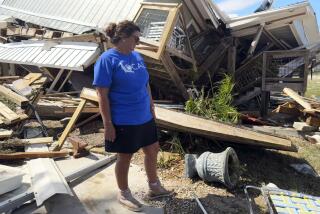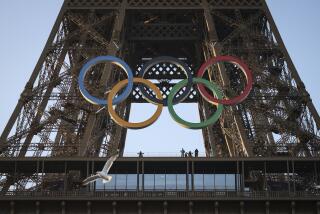You’ve Got to See It to Really Believe It
NEW ORLEANS — On a weekday morning not long ago, two state engineers left Baton Rouge to go hunting for places to deposit the remains of half a city. Before the ruined portions of New Orleans can be reconstructed, they must first be deconstructed and hauled away -- an estimated 22 million tons of debris, an amount 15 times more than the World Trade Center’s collapse generated.
About 40 miles from New Orleans, the pair -- 48-year-old Bijan Sharafkhani, who rode shotgun, and the driver, 31-year-old Jason Meyers -- began to pass billboards erected after Hurricane Katrina.
“NO MATTER WHAT,” vowed one, sponsored by a construction firm, “we are moving back to our city NEW ORLEANS.”
“Hey Louisiana,” shouted another, placed by a potato chip maker, “let’s build it back EVEN BETTER!”
These defiantly upbeat messages echoed the rhetorical flourishes swirling about New Orleans in the last month. Even as the last evacuees were being pulled from rooftops, there was spirited talk of rebuilding New Orleans as a “shining new city,” if not on a hill, at least on a swamp with improved levee protection.
What Sharafkhani and Meyers were to witness -- as it happened, it was the day before Hurricane Rita came ashore -- would be a sobering counterpoint to the gospel of renewal. Driving through the freshly drained eastern portions of the city, they received a ground-level indoctrination into just how arduous the task ahead will be.
“Watching the news,” Meyers would say at the end of the tour, his voice soft, almost disbelieving, “you don’t realize how big this is. We drove around for -- what? two hours? -- and saw nothing but destruction, nothing.”
‘Three-Dimensional Chess’
The process of rebuilding New Orleans has barely begun, yet it is possible to detect emerging fault lines beneath the effort that will, in large measure, determine its outcome. One early point of friction is how fast to move with demolition.
The day before Sharafkhani and Meyers went dump-hunting, the city’s politically potent historic preservationists had convened in a ballroom of Baton Rouge’s Old Governor’s Mansion, a monument to the late Huey P. Long. They had come to beat the drum for going slow, for working house by house to make sure that every structure of historical value that can be saved will be saved.
They warned against “the bulldozer approach” and challenged any notion that health and environmental concerns, not to mention sheer logistics, demand a more rapid demolition. Individual property rights, the preservationists said, would be their battle cry.
“Don’t let government use government as an excuse not to save your house,” declared New Orleans City Councilwoman Jacquelyn Brechtel Clarkson, whose district includes the French Quarter and, just across the river, Algiers.
She made reference to the federal Environmental Protection Agency and the Centers for Disease Control: “Don’t let government from outside the city come and say: ‘You have an EPA problem. You have a CDC problem. We have to demolish your home.’ That’s an old way. Don’t let them get away with it.”
Whether undertaken house by house or street by street, with or without input from preservationists, the demolition of much of the city’s eastern neighborhoods is inevitable, and some people have begun trying to gaze beyond the coming debris piles and burn pits to imagine what might arise from the ruins.
One is J. Stephen Perry, president of the convention bureau, a member of several civic boards, former chief of staff of a previous governor -- in short, a player. He sat last Sunday morning in the lobby of the Capitol Annex in Baton Rouge, beneath a vaulted ceiling and walls decorated with Depression-era Works Progress Administration tableaux, and talked about what many are calling the “new New Orleans.”
With a brisk shake of his head, he dismissed the idea of willy-nilly demolition: “You need to be careful before you start tearing things down. The easiest approach is to bulldoze a neighborhood. That is not going to happen here.”
At the same time, he went on, the badly damaged neighborhoods to the east are what will allow New Orleans “to literally develop a living template of urban reform, something that we never before had an opportunity to even dream about in the United States.”
It is a point made often by those who contemplate rebuilding New Orleans. Spared by Katrina, for the most part, were the city’s most viable portions: the French Quarter, which brings in the tourists; the hotels, which put them up; the older, architecturally refined neighborhoods that attract a core of urban professionals (and give the tourists something to do beyond trolling Bourbon Street); the Central Business District; the port and its shipping construction. These will provide a starting point for renewal.
Lost, in the main, but not exclusively, were poorer neighborhoods where tourists rarely ventured. And these, once cleared, will offer a canvas on which the urban visionaries can paint. In this view, what the floods accomplished, albeit brutally, was something no politician could ever suggest: Take the poorest and most crime-ridden portions of a city, sweep them more or less clean, and start anew.
Of course, such social engineering could draw battle lines beyond demolition: over who will control the effort, who will land the contracts, who will be hired to do the work, how much to rebuild and how much to leave as open space, how to negotiate the racial divide, how extensively to fix the city’s levee system.
Only in the last week or so, Perry said, as shock subsided and cellphone coverage improved, have he and other business leaders begun to meet in small groups to explore just how this do-over might unfold.
On Friday, Mayor C. Ray Nagin started another discussion, announcing a 17-member Bring Back New Orleans Commission.
For his part, Perry (who was not named to Nagin’s group) spoke enthusiastically about green space, better schools, new health clinics -- the opportunity to “create the kind of environment that will build pride and change the social dynamic” and that might bring back New Orleans evacuees now scattered across the nation.
In time, he said, the challenge might even capture the imagination of the country, drawing in young urban pioneers determined to set a city right.
Not that any of this will come fast, or unfold in an organized linear fashion. Rather, he said, it will be “a game of three-dimensional chess.”
A Wasted Landscape
Sharafkhani and Meyers were not engaged in three-dimensional chess. Nor did they appear to be part of any bureaucratic “them” conspiring to destroy the century-and-a-half-old shotgun houses -- wooden structures so narrow that, it’s said, a shotgun blast through the front door would exit through the back and blow a hole in every room -- that are an architectural presence in some flooded neighborhoods.
They were just a couple of midlevel scouts from the state Department of Environmental Quality, looking for dumping capacity. On the drive east on Interstate 10, the pair bantered about roadside Cajun cafes they’d discovered in far reaches of the state on their rounds. They quizzed a tag-along from California about the proper pronunciation of exotically spelled Louisiana locales.
They made stops just outside the city, visiting two huge landfills that already were receiving 400 truckloads of debris a day, roughly five times the normal amount. The trash -- brush, tree limbs, construction material, refrigerators -- mostly came from the less damaged suburbs on the west bank of the Mississippi.
Then they crossed the river, passed through the Central Business District and dropped into the eastern city, following surface streets through the Lower 9th Ward and toward St. Bernard Parish. Here, the chatter about fried chicken livers and the native pronunciation of Thibodaux ceased. Here, the rhetoric of rebuilding will have to confront the reality of how much work remains before the first new foundation is laid.
For a long time, they rode in silence, as if trying to comprehend what they saw. Block after block, neighborhood after neighborhood, mile after mile, the imagery of ruin was the same: Power lines and trees tangled across yards, cars and boats sat in the street at strange angles, brown muddy high-water marks reached near houses’ rooflines -- a death sentence, in the view of many construction experts.
Many houses had small escape hatches hacked into their roofs. Cryptic messages had been spray-painted by search-and-rescue crews, hieroglyphics marking the date of search, the units involved, the number of bodies found, the number of people and pets rescued.
What created the most powerful impression, however, was not the degree of damage. Many of the houses, in fact, seemed intact despite the telltale muddy lines. Rather, it was the scale. The scene just went on and on and on, to an extent that television footage, or satellite photography, or statistics or even words could not convey.
Absent the proper language, Sharafkhani and Meyers and their passenger were reduced to speaking in cliches.
“This is a war zone,” said Meyers at one point.
“This is a tragedy,” said Sharafkhani at another.
“This is depressing.”
“This is sad.”
Making it all the more strange was an almost total absence of animation. There might be a sentry posted here, a frazzled cat skulking there, but mostly, if the early winds of Hurricane Rita hadn’t been stirring half-fallen power lines and crippled trees, the travelers might have been looking at a still life.
At the entrance to St. Bernard Parish, which had more than 20,000 wrecked houses of its own, they were stopped at a sheriff’s checkpoint. On either side of the road were haphazard rows of storm-tossed boats and cars. Behind these were commercial buildings torn in shreds. A deputy asked the pair where they were headed.
“We’re just looking for a staging area,” Sharafkhani said, “for the debris.”
“For the ‘debris’?” the deputy repeated, his tone scoffing. He forced out a loud laugh. Apparently, he found it bitterly comical to describe the wreckage that surrounded him with a word so banal as “debris.”
“Have you seen this?” he said, waving to the cars, the boats, the strip malls in ruins.
“Well,” he said finally, waving the engineers through, “go at it.”
Their only other human encounter occurred when they stopped to investigate a closed dumpsite on what has since been designated a nature preserve. A sunburned hard hat was directing a crew buttressing a broken levee.
Sharafkhani asked about the site, which like most places scouted that day seemed to offer no real answer to the challenge ahead. Then they fell to talking casually about the scale of destruction. Sharafkhani said it looked to him like nine out of 10 houses in the flood zones would have to come down.
It was, he said, unbelievable.
The foreman nodded.
“It’s like someone came through and dropped bombs every couple of blocks. Boom. Boom. Boom. Boom. Boom.
“It’s a bulldoze job,” the hard hat concluded, “that’s for sure.”
Back on the road, Sharafkhani started to work out a math problem aloud. He figured, conservatively, that 100,000 houses would have to come down in Orleans Parish. This number left out St. Bernard and other parishes in greater New Orleans, and also all the cars and boats and commercial structures that would require disposal somewhere.
Each house, he said, would produce two or three truckloads of debris, for a total of as many as 300,000 truckloads -- and the major landfills he’d visited earlier were straining to accommodate 400 or so trucks daily.
He did not bother to divide the number of truckloads by the number of days, or weeks, or months it would take to handle them all. He reduced the calculation to a single word: “Years.”
“We are talking years.”
More to Read
Sign up for Essential California
The most important California stories and recommendations in your inbox every morning.
You may occasionally receive promotional content from the Los Angeles Times.











